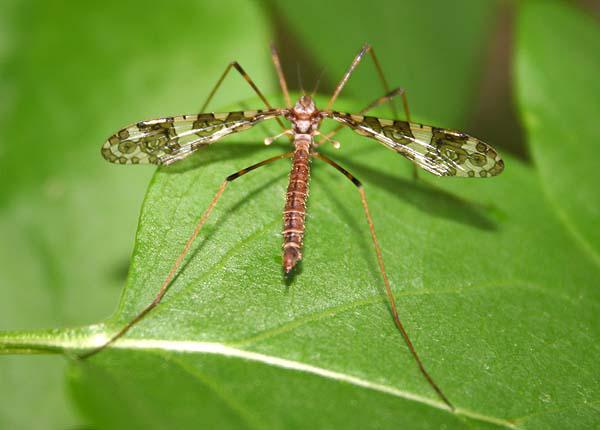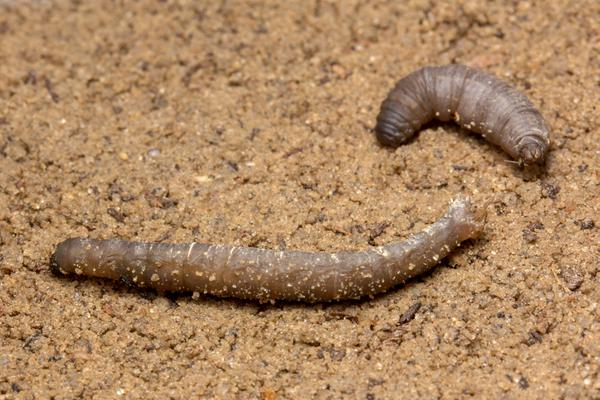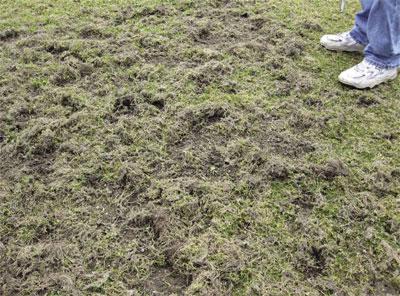Description
Adult crane flies (Tipula spp.) are large insects that resemble giant mosquitoes (Figure 1). Although the crane fly wingspan may be two inches across, they are clumsy and weak fliers and can often be seen resting on the side of a building or structure. Crane fly larvae, or maggots, are approximately 2-3 inches long and have no legs, unlike caterpillars (Figure 2). Over time, the larvae develop a tough outer skin and can sometimes be referred to as “leatherjackets”.
Pest Status
Although intimidating looking due to their large size, crane fly adults cannot bite and are not associated with transmitting human diseases. Crane fly larvae, however, can cause damage in a number of field crops including turf, pasture, forestry and agricultural crops beds.
Biology
Crane flies emerge in summer, fly, mate, and lay their eggs in the thatch of the grass. Eggs hatch and small, brown larvae feed throughout the fall until they overwinter. As temperatures increase in the spring, larvae continue feeding and maturing. In early summer, larvae pupate just below the soil surface.
Damage
Crane fly larvae chew on the roots and crowns of the turf and larger instars will come up at night to feed on the foliar tissue. Damage is usually more noticeable late fall and in spring when larger, overwintered larvae have resumed feeding. Damage typically starts as a general thinning of the turf which progresses to larger, brown patches (Figure 3). Unless they occur in large numbers, crane flies are considered nuisance pests on golf courses.
Control
Cultural Control
Proper mowing and fertilization to encourage a healthy turfgrass stand will minimize the likelihood of a crane fly infestation and help turf outgrow damage as it occurs. Avoid irrigating the turf under wet conditions if eggs are present and provide better drainage for chronically wet areas. Allowing the grass to dry will increase the likelihood of egg desiccation (drying out). Remove excess thatch to minimize habitat areas for crane fly larvae.
Biological Control
Birds, ground beetles and parasitic organisms can reduce crane fly populations in areas with fewer inputs. Applications of the insect-parasitic nematode Steinernema feltiae may give up to 50% reduction when properly applied.
Chemical Control
Crane flies are generally more of an issue in the northeast, particularly in cool-season grasses. Control measures are rarely required in North Carolina. Soapy water flushes may be a good diagnostic tool for determining the size of maggot populations.
| Insecticide and Formulation | Amount per 1,000 sq ft | Precaution and Remarks |
|---|---|---|
| chlorantraniliprole (Acelepryn) | 0.184 to .367 fl oz | Higher rate may be needed for older instars. |
| carbaryl* (Sevin) 80 WSP | 6 fl oz | |
|
clothianidin (Arena) 50 WDG |
0.22 to 0.29 oz |
Apply in the spring, when larvae are mature but prior to pupation |
References
- Crane Fly Larvae Can Be Devastating to Turf. Dale, D. 2018. Turf {magazine}.
- 2018 Pest Control for Professional Turfgrass Managers. Bowman, D. et al. 2017. NC State Extension Publication AG-408. 81 pp.
- Extension Plant Pathology Publications and Factsheets
- Horticultural Science Publications
- North Carolina Agricultural Chemicals Manual
For assistance with a specific problem, contact your local Cooperative Extension Center
Publication date: Oct. 25, 2017
Recommendations for the use of agricultural chemicals are included in this publication as a convenience to the reader. The use of brand names and any mention or listing of commercial products or services in this publication does not imply endorsement by NC State University or N.C. A&T State University nor discrimination against similar products or services not mentioned. Individuals who use agricultural chemicals are responsible for ensuring that the intended use complies with current regulations and conforms to the product label. Be sure to obtain current information about usage regulations and examine a current product label before applying any chemical. For assistance, contact your local N.C. Cooperative Extension county center.
N.C. Cooperative Extension prohibits discrimination and harassment regardless of age, color, disability, family and marital status, gender identity, national origin, political beliefs, race, religion, sex (including pregnancy), sexual orientation and veteran status.



